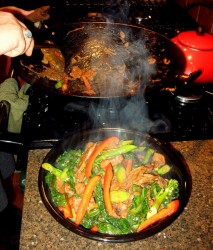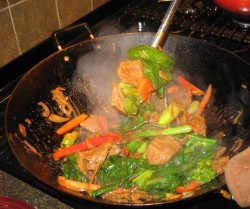Uber-Umami, Part II: Beef And Gai Lan with Ground Bean Sauce
So last week, when I posted my recipe for Pork, Tofu and Gai Lan with Ground Bean Sauce, Rose, who is now living in Taipei, (and thus should not have any trouble finding the uber-umami ingredient!) asked if she could successfully substitute chicken or beef in it, as she does not eat pork. With the chicken, I answered it would be a simple matter of using about 1/3 less bean sauce and adding a splash more of the wine, but the beef was another matter.
Beef has a much different flavor than pork, and I have found that I am more successful with exchanging pork and chicken in recipes than pork and beef. There is an inherent sweetness and delicacy of flavor to pork that beef simply does not have, and In my experience, to exchange one for another in a Chinese recipe without changing the seasonings accordingly, is asking for a dish that tastes okay, but not great.
And why make something that just tastes okay? Why not excellence?
So, I thought about it, and since I had another bundle of that absolutely fresh and delectable gai lan that needed cooked up right away, I decided to pull out a piece of top round from the freezer and experiment.
Generally when I make a stir fry of beef and gai lan, I stick very closely to the classical Cantonese formulation, which pairs the two ingredients with umami-laden oyster sauce. Oyster sauce, with its oceanic fragrance, has the distinction of bringing out the deeper flavors of beef and softening them, enhancing the meat with a rich sweetness. I often also use fermented black beans, which with their sharp, musky tang, really bring out the darker flavors of beef, while also counteracting the slight bitterness that resides within the gai lan. The combination is so good that I often find myself reaching for the oyster sauce and fermented beans on a cold winter weeknight when I have beef and gai lan and I need a fast meal that requires little thought.
But, variety is the spice of life, is it not?
So, what is the harm of making up a different recipe for beef and gai lan?
It turns out there is no harm in it at all, it just requires that one reflect on the nature of beef and change the ingredients accordingly.
I changed the aromatics completely. For starters, I switched out the scallions with a thinly sliced onion–about 1/2 cup of very thin slices. These I cooked until they were golden and slightly caramelized, which laid a foundation of sweetness into the dish that beef inherently lacks. I lowered the amount of garlic and raised the amount of ginger; for whatever reason, I prefer the sweetness of ginger with pork and the tingling fire of ginger with beef. I then added to the aromatics two frozen small sliced red Chinese chiles. These were not too hot, but the zing that they brought to the dish really enhanced the strong flavors of the beef, greens and sauce. One could leave them out, but I thought they were a nice addition.
I revamped the marinade, as well. I switched to dark soy sauce, which is great with beef, and raised the amount of ground bean sauce to two heaping teaspoons. This I added to the marinade along with a full teaspoon and a half of chile garlic paste. I lowered the amount of sugar, and kept the Shao Hsing amount the same. Since I used more meat, I added a bit more cornstarch to bind the marinade.
Finally, I also added a small red sweet bell pepper late in the stir fry process so that the slices stayed crisp and brilliant colored. The reason for this was simple–I wanted to add another note of sweetness that was not sugar to the dish, and the contrast between the emerald greens and the scarlet pepper was stunning. One must always remember that the visual appeal of Chinese food is just as important as the flavor, aroma and texture.
How did it turn out?
I asked Zak and Morganna which version they liked better–the traditional one or the new one.
They could not make up their minds.
The ground bean sauce enhanced the natural flavor of the beef to the extent that the sauce, which clung to the meat, greens and peppers tightly, tasted as if it was nothing more than spicy meat juices. It was a very beefy, meaty, savory experience, and I couldn’t decide myself which recipe was superior.
So, Rose–here it is, just for you–my detailed and illustrated answer to your question.
If you get a chance to make it, let me know what you think!
Rose’s Beef And Gai Lan with Ground Bean Sauce
Ingredients:
1 pound top round, trimmed of most fat and cut into thin 1″X1/4″X1/8″ slices
1 teaspoon dark soy sauce (I used Pearl River Bridge Brand)
1 1/2 tablespoons Shao Hsing wine
2 heaping teaspoons ground bean sauce
1 teaspoon chile garlic paste
1/4 teaspoon raw or brown sugar
1 1/2 tablespoons cornstarch
3 tablespoons peanut oil
1 small onion, peeled and sliced thinly (about 1/2-3/4 cup slices)
1 garlic cloves, sliced thinly
2 fresh or frozen red Chinese chiles, sliced thinly on the bias
2″ cube fresh ginger, peeled and sliced thinly
1/2 tablespoon dark soy sauce
2 tablespoons shao hsing wine
1 pound gai lan (Chinese broccoli), thick stems cut on the bias into bite sized pieces, and separated from the leaves
3 tablespoons chicken broth
leaves of the gai lan, cut into rough pieces
1 small red sweet bell pepper, trimmed, cored and cut into 1/4″ thick slices
scant 1/8 teaspoon toasted sesame oil
Method:
Toss beef with the next six ingredients and allow to marinade for at least twenty minutes.
Heat wok on the highest heat setting your stove can manage until a thin thread of smoke wafts upward. Add the peanut oil, and allow to heat up for another thirty seconds. Add the onions and stir and fry until they turn golden–about two minutes. Add the garlic, chiles, and ginger, and stir and fry another thirty seconds or so.
Add the meat, spread it out into one layer and leave it undisturbed on the bottom of the wok to brown for at least one minute. When you can smell and see browning occur, begin stir frying, and cook until half the meat is brown and half is still red. Add the second measure of soy sauce and wine. Keep stir frying until only 1/3 of the beef is red.
Add gai lan stems and stir fry one more minute. Add the chicken broth and the gai lan leaves, and scoop up the meat from the bottom of the wok and lay it atop the leaves, and stir and fry until the leaves brighten in color and just begin to wilt. Add the bell pepper and continue stir frying until the leaves have wilted and become velvety, the meat is brown and the bell pepper is barely cooked.
Remove wok from heat and drizzle with the sesame oil.
6 Comments
RSS feed for comments on this post.
Sorry, the comment form is closed at this time.
Powered by WordPress. Graphics by Zak Kramer.
Design update by Daniel Trout.
Entries and comments feeds.





WOW! When I asked you that question I never expected a whole new receipe as an answer!!!
Your take on bringing out the deeper flavors of meat is a great exercise in showing me (and the rest of your audience) how to adjust recipes. Something I need to get a better hang of…
I will definitely be trying this soon. One of my roomates is of cantonese heritage (though american reared) and I’m sure she’d love to try this.
After reading this receipe I also realized two things, gai lan is what I know as jie lan in mandarin and that i have a whole jar of ground bean sauce my mom left me after her visit in early december (she cooked for us, including both roomates, everyday…it was heaven). She used it to marinate her beef stir fry (but she didn’t use the same vegetable, a different less bitter, more leafy one was used, though i don’t know its name)!
I’ll let you know how it goes 🙂 Thanks so much again barbara!
Comment by Rose — January 9, 2007 #
This discussion on how you balance and enhance the flavor of the particular meat you’re using is fascinating.
Comment by Danielle — January 9, 2007 #
Rose, you are of course welcome. After you asked the question, and I gave the answer of how I would change it, I decided that I needed to make sure that it would taste good. My imagination and taste memory said it would, but my tongue wanted its say as well! Besides, you gave me an excuse to try new ideas in the kitchen–always a good thing. With the bout of PPD, I had suffered a break in my usual innovative thinking, and so any nudge is helpful, wanted and useful! Thank you!
I am not surprised to find that I know gai lan by its Cantonese name. What Chinese I know I have learned from two sources: Hong Kong movies (I adore Wushu films), which are in Cantonese, and from Cantonese proprietors of various Asian markets and restaurants. So, my Mandarin is woefully lacking.
That other leafier green, not so bitter could have been what I know as choy sum–it looks exactly like gai lan if you glance at it, but the texture is crisp and juicy–gai lan is firm and dry–and the flavor is lighter and for want of a better term, “greener.” It has an herbal flavor sort of like mizuna, if you have ever had that. You cannot cook it as long as gai lan, because it will lose its water and thus its crunch and texture, but it tastes really good in a stir fry, or as a garnish in a braised dish or a soup.
That may be what your Mom cooked with the beef.
And what a great coincidence that you have a jar of it in your fridge!
Danielle and Rose–as for balancing flavors to the meat or other ingredients I am using–that is something I have learned almost exclusively from deep study of Chinese cuisines, as well as my training in classical French cooking. It is something I started thinking about in culinary school, and as I started really working with Cantonese cooking in the past few years, I really started to understand the many flavors of fermented soybeans and how great Chinese chefs and home cooks have used them for centuries to bring out the natural goodness of their main ingredients in a dish.
That is what I love best about Chinese cookery. Not only is it in general healthy and beautiful, there is enough for me to learn over a liftetime to keep me forever fascinated. I will never learn the totality of all there is to know, and that is a wonder and a joy to me.
Comment by Barbara — January 9, 2007 #
If I can’t find a source of Gai Lan at the moment, would it be terrible to substitute broccoli? I’m thinking about cooking times – it’s a little thicker, I think, so could I just up the time by a few minutes but keep the flavoring the same?
Comment by Becca — January 9, 2007 #
All this talk about ground bean paste and gai lan/jie lan has jogged my memory a bit more. I think my mom actually marinated the beef in the paste during the day, sliced it and added it to the stir fry (rather than making it a part of the sauce)..also, the sauce was very peppery.
I’m really not sure about what vegetables she used. It may have been the ones my uncle has planted in his yard outside of taipei. I forgot to mention that i conveniently have a free and fresh source of papayas/lemons/kumquats/leafy greens/herbs? he lives alone and gives his extras to me when he comes into the city, so nice!
I think i’m going to have to call my mom this weekend and ask what she used and how she did it. i remember how the dish tastes, not how she made it.
Comment by Rose — January 10, 2007 #
Becca–broccoli is fine as a substitute. I would peel the big stalks and cut them into coin-shaped slices and use them, too.
You could briefly blanch or steam the broccoli before stir frying it to make it more tender and make it easier to cook.
Or, you could put it in sooner in the recipe than I tell you to put in the gai lan.
Rose–you are SO lucky! What a good uncle!
The marinade that stuck to the beef in your mother’s recipe, I am sure is the basis of the sauce. In my experience, that makes a tastier sauce, anyway….
Comment by Barbara — January 10, 2007 #